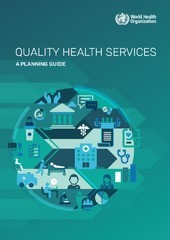Provision of Care
Implementation resources and tools
This page suggests select tools, resources, and packages to support country implementation of key quality of care approaches.

The WHO Labor Care Guide User’s Manual (2020) has been developed to help skilled health personnel successfully use the WHO Labour Care Guide. The WHO Labour Care Guide is a tool that aims to support good-quality, evidence-based, respectful care during labour and childbirth, irrespective of the setting or level of health care.

In 2020, building on implementation approaches adopted as part of the multi-country Network to improve quality of maternal, newborn and child healthcare, WHO published ‘Quality Health Services: a Planning Guide’ for improving quality of health services. The guide highlights key actions at national, subnational (regional/district) and facility level to improve and sustain quality health services and identifies five foundational requirements across system levels for achieving quality health services including on-site support, measurement, sharing and learning, stakeholder and community engagement and management. This guide can be used by policy makers and maternal, newborn and quality of care program managers to plan and improve maternal and newborn health care at scale.

The 2018 ‘WHO Handbook for national quality policy and strategy: a practical approach for developing policy and strategy to improve quality of care’ is a useful resource for policy makers and program managers supporting the development or revision of national maternal and newborn quality of care policies and strategy.

The QoC MNCH Network Monitoring Framework outlines QoC indicators that can be used by national/subnational mangers, facility managers, and health workers to monitor and guide improvements in care including management of subnational MNH quality improvement programs. It includes an appendix of recommended common MNH quality of care indicators in Annex 1 and a ‘catalogue’ of flexible MNH QoC indicators categorized by quality statements for use by QI teams working to improve care in specific technical areas.

The 2020 Maternal and Perinatal Death and Surveillance and Response: Materials to Support Implementation provides a roadmap for conducting Maternal and Perinatal Death Surveillance and Response (MPDSR) in clinical and policy settings. This document is a practical step by step guidance, relevant to establish a framework to assess the burden of maternal deaths, stillbirths and neonatal deaths, including trends in numbers and causes of death and on how to link maternal and perinatal death reviews. It is important to generate information about modifiable factors contributing to preventable death, and to use the information to guide action in order to prevent similar deaths in the future. The document promotes confidentiality and a “blame free” culture fostering accountability for results and compelling decision-making.

